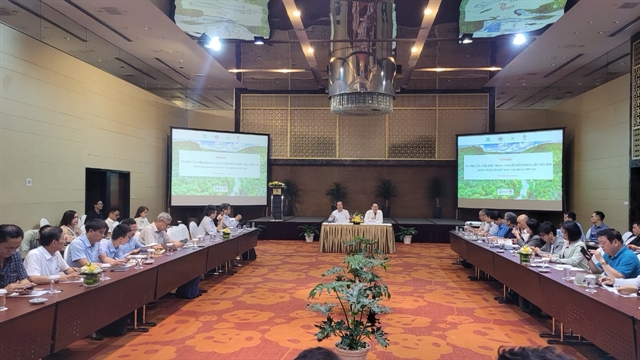 Society
Society


|
| An overview of the seminar. — VNS Photo Tố Như |
HÀ NỘI — Việt Nam has much potential to convert production systems from high emission fuels like coal to wood pellets, reducing emissions on a national scale, heard a seminar in Hà Nội on Friday.
Organised by the Vietnam Timber and Forest Products Association, Vietnam Thermal Science and Technology Association and Forest Trends, the seminar aims to encourage small production facilities that use steam turbines to convert their systems from high-emission fuel sources like coal and oil to low-emission wood pellets.
Steam turbines are used in Việt Nam's industrial production to provide heat, steam and hot water for both light and heavy industries. Meanwhile, biomass (rice husks, wood chips, sawdust and wood pellets) and electricity, gas, oil or coal can be utilised to produce steam.
According to Trần Văn Lượng, chairman of the Vietnam Thermal Science and Technology Association, about 9,000 industrial boilers are currently in use in Việt Nam.
Coal is used in many establishments to run boiler systems. Converting the coal input of these facilities to cleaner fuel sources has great potential to reduce emissions on a national scale, he said.
In recent years, there has been significant growth in the pellet business in Việt Nam, particularly wood pellets. The pellets are manufactured using waste byproducts from the wood industry, including firewood branches, tree tops, sawdust and shavings.
Approximately five million tonnes, or 95 per cent of the pellets produced in Việt Nam, are exported, mostly to the Korean and Japanese markets. In those countries, coal is mostly replaced by imported pellets as an input fuel for electricity production.
Currently, Việt Nam’s usage accounts for around 5 per cent of domestic pellet production, primarily in small-scale production facilities' boiler systems.
Lượng stated that despites advantages of using pellets, there are still obstacles that enterprises must overcome in order to convert their boilers to biomass. These hurdles include a lack of standards and investment funds for the transformation.
One of the other challenges is that the domestic carbon market has not yet been formed, so it has not created a driving force for businesses to transition, he told the seminar.
Tô Xuân Phúc, from Forest Trends, said the Vietnamese Government has made a strong commitment to achieving net-zero emissions by 2050. There is much potential room for pellet use in the domestic market.
Some companies that export wood claim that when demand in Việt Nam starts to rise quickly, the wood pellet industry will have a chance to grow its market.
Specifically, in 2024 and 2025, the need for pellets in Japan is expected to rise and could triple. In the next two to three years, the supply and demand for this commodity will be balanced if Việt Nam's production capacity is kept at its current level.
In spite of export potential, the manufacture of wood pellets confronts difficulties in controlling product output and quality, as well as future raw material shortages.
Việt Nam exported 4.6 million tonnes of wood pellets in 2023, valued at around US$680 million. — VNS